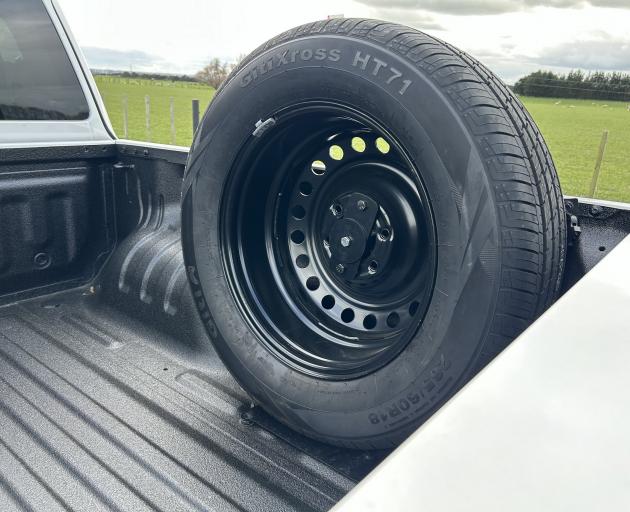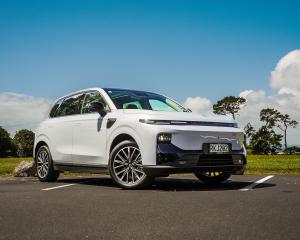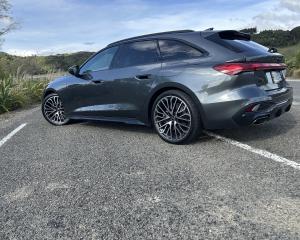
Plug-in hybrid utilities are an emergent thing, but the GWM Cannon Alpha is looking handy for physical dimension, muscularity and electric-pure range. It has the biggest battery, seems solid at proper off-roading, holds a top tow rating and a strong pricing position.
A week of driving enforced how close it comes to emulating what you'd expect from a four-wheel-drive diesel ute, on seal and beyond.
Slotting a 2.0-litre turbo-charged petrol engine into a ute this size isn’t the big call it might seem, because of the electric ingredient. The petrol engine alone provides a decent enough 180kW and 380Nm, but add in the electric motor, and up to 300kW and 750Nm is available, That’s not only substantially more than GWM achieves with the mild hybrid Cannon but also amongst the very best achieved by other brands.
If the electric motor is solid, the battery that feeds it is substantial. At 37.1kWh, it is of a capacity Nissan believed was sufficient for the fully-electric Leaf until recently.
"Fire it up and go" simplicity sells a diesel. You can drive the PHEV that way, too, but the smartest outcomes arrive from a driver being in the mood for modes.
Depending on the state of battery, the Cannon Alpha PHEV can operate as a fully electric machine or as an assisted petrol. Or it can be a petrol-driven vehicle that, at same time, is using the engine to replenish the battery.
Take-offs are consistently on battery-fed impetus. At urban pace, you can be lulled into thinking it is an electric vehicle that relies on combustion power as a back-up. And, if kept in EV mode, it will motor open-road speeds without the petrol engine. For a while.
Ultimately, of course, it still needs combustion assistance. The more you ask of it and the further you take it, the more petrol-prioritisation is provided, and not just for turning the wheels. The Cannon Alpha PHEV’s hybrid system harvests power via regenerative braking, but also from the engine acting as a generator.
GWM claims a combined fuel consumption of 1.7L/100km with a full battery — allowing a theoretical 1060km total range. If presuming, unrealistically, that you’re prepared to fully recharge the battery after every 100km of travel. They also say it can deliver 7.9L/100km with the battery at a low state of charge. Plus 115km pure electric running.
These economy readings make fabulous reading. This test? Not so much. Cannon’s trip computer suggested an overall average from more than 400km of driving of 10.8 litres of dino-sauce per 100km and 2.6kWh/100km energy consumption, and an average of 35kWh/100km on EV-only mode.
That sort of fuel burn is akin to that often seen from a mainstream diesel ute, but it’s worth noting is that the Cannon Alpha is larger and heavier than most of those. Width is class usual, but it is almost American in height and length. In urban situations, you’re acutely aware of the latter, especially when the tail sticks out in angle parking.

My time reinforced it conforms to the same strength that every PHEV evidences. Driving short distances and replenishing the battery daily is a winning formula.
Also, there’s logic to prioritising EV purity for urban use and slow speed off-roading — where electric can deliver an enviable accuracy - then reverting primarily into hybrid (HEV) mode for general mud-plugging and any open road running.
HEV brings in petrol, but also keeps good relations with the battery-fed side. I used that on a long drive and saw good results, down to around 6.2 L/100km indicated, though that peak benefit didn’t last for all that long. I’d pretty much exhausted all the goodness 120km of a 210km run (I hadn’t begun with a fully charged battery).
For the remainder of that drive, I adopted Smart/Intelligent, which not only optimises the engine for driving, but also — when the set-up determines it is practicable — to act as a generator to replenish the battery. It still pulled strongly, but a clear change to the engine note was obvious.
While it clearly has lots of torque at low revs, the Cannon Alpha PHEV doesn’t wallop it with quite same oomph that you get with a diesel and there’s more keenness from the transmission to kick down when accelerating too. Still, the transmission is very refined, so even if it drops two or sometimes three gears to maintain impetus, it does so without being jerky.
Also impressive is how seamlessly the PHEV synchs with the broader functionality of this model. Utes are about utility, and four-wheel-drive types are about workhorse practicality. The Cannon Alpha PHEV fulfils both those functions.
On seal the four-wheel-drive system will only engage fully when the electronics sense a loss of grip, the intent being to boost fuel efficiency in everyday driving. The all-out off-road functions are all activated at the push of a button. Provision of a high- and low-range gearing, and a locking differential is not to be underestimated either.
In PHEV format you have the same 224mm of ground clearance as the regular Cannon, and the same 800mm of wading depth capability too. On that, the batteries have been given an IP67 water resistance rating. To achieve this, they needed to survive 30 minutes submerged in one-metre of water.
The diesel and mild hybrid Cannon have leaf-sprung rear suspension. To fit the battery, the PHEV goes to an independent rear set-up. It’s prone to lift a leg more easily, but more likely it is the road-tuned "Giti Xross" tyres that will be a hindrance in muck, though on-farm work on test was no issue.
Having the ute-standard 3500kg towing rating carry over for the PHEV is a big plus. As for how well it tows, well who knows; the test car lacked a tow bar.
It’s not a one-tonne ute in sense that the wellside weight limit drops to 685kg, which is more modest than the ICE (internal combustion engine) type’s. That’s possibly not going to inhibit general weekend warrior use, but the big faff is the spare wheel’s location.

But placing the spare in a cradle in the wellside is a sub-optimal solution. Most patently, it clearly inhibits fitting a canopy; beyond that, it just restricts how you use what would otherwise be a practically-sized load area.
Plus, in my instance, another issue arose: the spare has a vinyl cover that, had I not seen a movement in the rear view mirror, would have torn off in the slipstream first time I drove into a 100kmh zone. On seeing how it poorly it affixes (with two clips and magnetic tabs), I’m surprised it didn’t dislodge earlier.
So the cover came off on day one and, on day six, the spare also joined it in my garage.
That was because Mrs B wanted me to pick up some garden mulch. The wheel took up space and seemed set to get in the way, so I removed it. I should have also whipped out the wheel cradle then; it did need to come out subsequently because a lot of garden debris was trapped under it.
The battery’s extra weight seems to lend the PHEV a more settled ride quality than the other versions, but only to a point. You can feel the front-end bounce and jiggle at low speeds and, like the regular kind, extra weight in the rear settles it down. Still, on corrugated gravel for one, the PHEV felt smoother and more controlled than its non-PHEV counterpart.
Refuelling means ensuring the left flank is closest to the pump; replenishing asks you to ensure a public charging cable can reach the right side. A 50kW fast charger is a good choice, as that is the vehicle’s peak replenishment rate, with 30 to 80 percent fast charge in 26 minutes. AC home charging means pulling out the factory-provisioned cable that stows behind the rear seat. This is enabled at up to 6.6kW, so a full charge requires being hooked up for 6.5 hours.
The potential for vehicle-to-load (V2L) technology that allows powering external electrical devices up to 3.3kW sounds attractive, given that is a big sales point for Ranger. However, after searching for a household plug socket (starting with the deck, as that’s where Ford places theirs), I discovered that this is another PHEV that provides V2L via a special extra-cost power board that plugs into the charging port.
Inside, the vehicle has a king-of-the-road air that brings a commanding view and a cabin with plenty of room up front. Taller back-seat passengers will appreciate the recess in the headlining to sit comfortably, and they get decent leg room too.
Everything looks very premium and there is a solid span of comfort and convenience features. Yet fit and finish are not quite to class best, the seats are not all that shapely and some design elements are a bit OTT.
The GWM has a large digital instrument cluster, which allows the driver to go through a variety of functions, views and readouts, some easier to access than others.
Same goes for the infotainment. Hook up to Apple CarPlay and the screen will dedicate itself wholly to that display, but in doing so you lose instant access to the climate control. There is a bank of buttons below for quick functions, but not for full control of the system. In respect to controls, there is no physical volume dial. You can adjust it from the steering wheel (which is clearly inaccessible to a passenger) or via a screen menu, which is a faff.

Criticism last year of these being over-reactive caused GWM to effect some significant re-programming, notably to the speed recognition, emergency braking and lane-keep functions.
The PHEV was the first of the improved models I have tried and, yes, it is far better.
The $64,990 Lux has LED lights, a 12.3-inch touchscreen, artificial leather upholstery, and the full suite of safety systems. Including in the assists is a 360-degree camera system, along with parking sensors front and rear, which you will be depending on.
This entry-level fit out seems tasty enough, until you see how much more swag the Ultra implements for an additional $7000. Its extra features include heated and ventilated seats, massaging front seats with memory, a head-up display, interior ambient lighting, a 10-speaker sound system, front and rear wireless charging pads and a panoramic sunroof.
Although both variants have a sliding and reclining second row, that function is electric in the Ultra trim. The Ultra also has the niftier kind of tailgate.
Diesel is strong in the ute segment, but the Cannon PHEV is a genuinely thoughtful alternative. How it ultimately does for running cost might require some careful mathematics, all the same, and you wonder about road user charges. It has become detrimental to PHEV passenger buy-in, but has never restricted utes ... will this tech be a litmus test?
AT A GLANCE
GWM CANNON ALPHA LUX PHEV
Rating: ★★★★
Design and styling: ★★★
Interior: ★★★★
Performance: ★★★★

Safety: ★★★★★
Environmental: ★★★+
SPECIFICATIONS
Price: $64,990
Engine: 1998cc four-cylinder petrol engine with gearbox-integrated electric motor and mains-replenished 37.1kWh battery; 300kW/750Nm combined; four-wheel-drive; nine-speed automatic.
Safety rating: Five star Ancap.
Wheels and tyres: Alloy wheels, 265/60 R18 tyres.
Fuel and economy: 1.9 litres/100km (WLTP-3), tank capacity 7.5 litres.
Emissions: 66 grams per kilometre.
Dimensions: Length, 5445mm; width, 1991mm; height, 1924mm.
Kerb weight: 2810kg.
By Richard Bosselman












